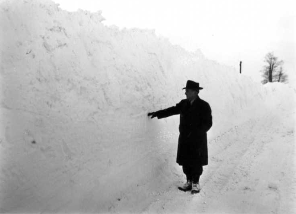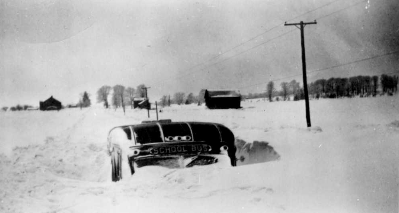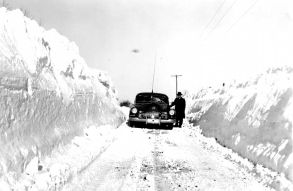Historians Address Question Of Winter Back In The Day
- The 1936 blizzard in the town of Carroll. Submitted photos
- Portage Road between Mayville and Westfield during a winter storm in the 1930s.
- Storms in the early 1930s also buried cars, along with roads because plowing equipment was not as good. Submitted photo
- Portage Road was eventually able to be opened to a single lane road, but during the 1930s storm, multiple roads were blocked off for days. Submitted photo

The 1936 blizzard in the town of Carroll. Submitted photos
Most everybody has probably heard the stories about how bad winters were back in the day, but are those stories true or just rumors?
Locally, there are plenty of records noting winter conditions — from snow totals to major storms — dating back to the early 1900s that paint a general picture.
In towns like Akrwright, major snow storms were recorded in the ’40s and ’60s.
“There was a lot of snow,” Arkwright Town Historian Ruth Nichols said. “We have pictures of snow in 1944 on Center Road. In the early ’60s there was a really bad storm that lasted a while. I know I got snowed out at least three different times, because I first moved up here in the ’60s. In recent years it has been better.”
Pam Brown, historian for the village of Panama and town of Harmony, said advances in snow removal equipment have likely played a role in how winters are viewed now compared to the past.

Portage Road between Mayville and Westfield during a winter storm in the 1930s.
“I guess I could say it was worse back then because the snow removal equipment probably wasn’t as evolved as it is now,” Brown said. “Snow couldn’t be cleared from the roads as quickly, so it was tough to travel, especially in the rural areas. Also I’ve been visiting with my parents who are longtime residents of Panama. They agreed that winters were much worse than they are now. But I still think snow removal is much improved.”
Brown added that in Panama, the Blizzard of 1977 was a big topic of discussion when it came to winters in the past.
According to the National Weather Service in Buffalo, there has been no significant trend over the last few years as to how the winters have been.
“Last winter there was 91 inches of snow in the Jamestown area,” Dan Kelly with the National Weather Service said. “The average is about 98.3 inches. This number has varied over the years, with some above average and some below. There has been no real trend. The last few years have been on the low side, but then in 2017 and 2018 it was 123.6 inches.”
In Silver Creek, there are a lot of records about the same 1977 blizzard, and more from earlier on.

Storms in the early 1930s also buried cars, along with roads because plowing equipment was not as good. Submitted photo
“1816 was the year without summer,” Silver Creek historian Louis Pelletter said. “It snowed in July. There were two major wind storms in October 1844 and 1886. Winter of 1855-56 I have listed as very severe and, in June 1859, there was a frost. Jan. 6, 1879, I have a note that the snow on the train tracks was 10 feet deep. A storm on Nov 11, 1881, there were 6 inches of snow, breaking trees and other damage.
“Major snow storms were in 1930, 1932, 1958, 1960, 1962, 1966 and 1977 to mention a few.”
Pelletter mentioned another storm — in March 1976 — where the entire village of Silver Creek lost power and needed a generator to be brought in.
“If I remember correctly, the generator was in Binghamton,” Pelleter said. “Had it not been available, we would have been without power for weeks. Fortunately, it was available and we had power provided in three days. I remember no electricity in the village including the street lights. There was no heat and we cooked on a gas or charcoal grill.”
Pelletter also had a news article describing the storm of 1932, which is known to be on the same level or worse than the one in 1977. The article describes motorists being told not to travel on the highway after 75 trucks were delayed by heavy snow. All eastbound traffic out of Silver Creek was stopped and hotels and tourist accommodations were filled to maximum capacity. More than 100 stranded travelers were accommodated in hotels, and it was estimated that others found places to stay in some people’s private homes.

Portage Road was eventually able to be opened to a single lane road, but during the 1930s storm, multiple roads were blocked off for days. Submitted photo
During the blizzard of 1977, Pelletter was working with the Hanover Police Department and had to help during the blizzard.
“The conditions were so bad that we were not required to wear our uniforms,” Pelletter said. “Snowmobile boots, a knit hat, long underwear under my street clothes, a sweatshirt and my police coat was what I wore. Later in the storm, I spent my time driving up and down Routes 5 and 20 looking for stranded motorists — that took a chance — and brought them to the Irving Diner — now Smith True Value lumber yard — or Lakeshore Hospital. Once at the Irving Diner, the Irving Fire Department volunteers would bring them to a shelter in Irving.”
Pelletter also remembered helping get stranded tourists to the Irving Diner.
“The winds and snow were so bad that I traveled on Routes 5 and 20 by looking for lights on buildings,” Pelletter said. “At one point, I found a number of stranded motorists around Lake Shore Hospital, buried in the snow. I was following the building lights with the police car full of stranded motorists, looking to get them to the Irving Diner. I believe it took me an hour to get to the light that I was following, thinking it was the Irving Diner. When I was able to identify where I was, it was actually the entrance to the Thruway. It probably took me another hour to get to the Irving Diner from the Thruway entrance.”
The Fenton History Center has multiple newspaper clippings from 1945, 1958, 1966 and 1976 reporting at least 5-foot drifts or higher multiple times, including some St Patrick’s Day storms.
Barb Cessna, Historian for the town of Carroll, reported a lot of snow in the Clymer areas in the 1980s, including minus-29 degree temperatures.
“I remember sending the clipping to my parents and teasing them about what they were missing, as they had moved to Florida in the fall of 1980,” Cessna said. “I’ll say it was the early 1980s. My dad, Harold Nelson, was on Clymer Sherman Road. The bigger snow, which was just below the cross pieces on the poles, was just around the corner on Clymer Hill Road, between our house on the corner and the next place, the Damcott farm.”
The Carroll Historical Society also had pictures from the 1936 St Patrick’s Day Storms, which also caused flooding just before the bridge coming into Frewsburg from Jamestown.





